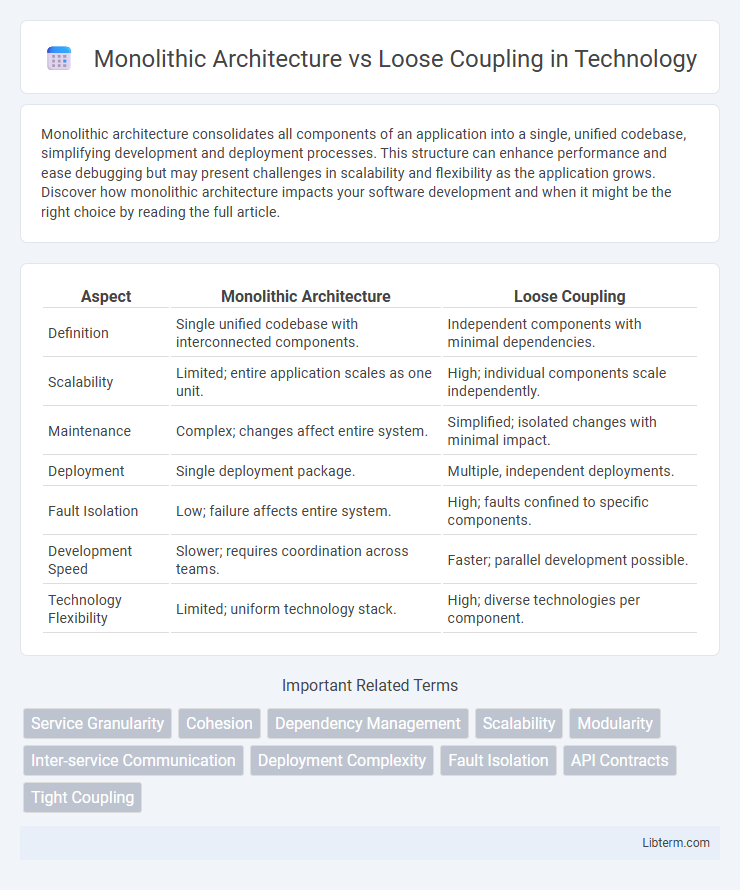Monolithic architecture consolidates all components of an application into a single, unified codebase, simplifying development and deployment processes. This structure can enhance performance and ease debugging but may present challenges in scalability and flexibility as the application grows. Discover how monolithic architecture impacts your software development and when it might be the right choice by reading the full article.
Table of Comparison
| Aspect | Monolithic Architecture | Loose Coupling |
|---|---|---|
| Definition | Single unified codebase with interconnected components. | Independent components with minimal dependencies. |
| Scalability | Limited; entire application scales as one unit. | High; individual components scale independently. |
| Maintenance | Complex; changes affect entire system. | Simplified; isolated changes with minimal impact. |
| Deployment | Single deployment package. | Multiple, independent deployments. |
| Fault Isolation | Low; failure affects entire system. | High; faults confined to specific components. |
| Development Speed | Slower; requires coordination across teams. | Faster; parallel development possible. |
| Technology Flexibility | Limited; uniform technology stack. | High; diverse technologies per component. |
Introduction to Software Architecture Paradigms
Monolithic architecture centralizes all software components into a single, cohesive application, simplifying deployment but often hindering scalability and flexibility. Loose coupling, exemplified by microservices, promotes modular design where independent components interact through well-defined interfaces, enhancing maintainability and adaptability. Understanding these paradigms is critical for designing software systems that balance performance, scalability, and development velocity.
Defining Monolithic Architecture
Monolithic architecture refers to a software design approach where all components and functions are integrated into a single, unified codebase, resulting in tightly coupled modules. This design simplifies deployment but often leads to challenges in scalability, maintainability, and agility as the entire system must be modified and redeployed for updates. In contrast, loose coupling emphasizes modularity by separating components into independent services, enhancing flexibility, and easing updates and scaling of individual parts.
Understanding Loose Coupling
Loose coupling in software architecture emphasizes designing components that minimize dependencies, allowing independent development, testing, and scalability. This approach enhances system flexibility, fault tolerance, and maintainability by enabling components to interact through well-defined interfaces or APIs instead of direct integrations. Compared to monolithic architectures, which bundle all functionalities tightly together, loose coupling supports distributed systems and microservices, making it ideal for evolving and complex applications.
Key Characteristics of Monolithic Systems
Monolithic architecture features a single, unified codebase where all components are interconnected and deployed as one entity, leading to simpler development and testing processes. This architecture often results in tight coupling, making scaling and maintaining individual modules challenging due to the shared dependencies and intertwined logic. Performance can be optimized within a monolithic system since all modules run within the same process, but flexibility and fault isolation are limited compared to loosely coupled architectures.
Benefits and Drawbacks of Monolithic Architecture
Monolithic architecture offers simplicity in development and deployment by packaging all components into a single unified codebase, which enhances performance due to direct communication between modules but poses scalability challenges as changes in one part can impact the entire system. This architecture facilitates straightforward debugging and testing, yet it can lead to slower release cycles and reduced flexibility because updates require redeploying the entire application. Organizations using monolithic architecture may face technical debt and difficulty integrating new technologies, limiting adaptability in fast-evolving markets.
Advantages of Loose Coupling
Loose coupling enhances system flexibility by allowing individual components to be modified or replaced independently without impacting the entire architecture. It improves scalability and maintainability through reduced dependencies, enabling faster development cycles and easier integration of new features. This architectural approach increases fault tolerance by isolating failures within discrete modules, minimizing the risk of cascading errors across the system.
Performance and Scalability Comparison
Monolithic architecture often delivers superior performance through tightly integrated components and reduced inter-process communication overhead. However, loose coupling in microservices or modular designs enhances scalability by enabling independent deployment, horizontal scaling, and fault isolation across distributed systems. While monoliths may face bottlenecks under load, loosely coupled systems support dynamic resource allocation and resilience, optimizing scalability for growing demand.
Maintainability and Flexibility Considerations
Monolithic architecture's tightly integrated components often result in reduced maintainability and limited flexibility due to complex interdependencies that complicate updates and scaling. Loose coupling enhances maintainability by isolating changes within individual modules, enabling easier debugging, testing, and deployment without affecting the entire system. Flexibility is improved through loose coupling, allowing organizations to adapt and evolve software components rapidly in response to changing business requirements.
Use Cases: When to Choose Monolithic or Loose Coupling
Monolithic architecture suits use cases requiring rapid development and straightforward deployment, such as small to medium-sized applications with limited scalability demands. Loose coupling is ideal for large-scale, complex systems needing high scalability, flexibility, and independent service updates, like microservices in enterprise environments or cloud-native applications. Choosing between them depends on factors like team size, application complexity, deployment frequency, and scalability requirements.
Future Trends in Architectural Design
Future trends in architectural design emphasize shifting from monolithic architecture to loose coupling to enhance scalability and maintainability. Microservices and serverless computing are dominant patterns facilitating independent service development, deployment, and scaling. Emerging technologies like container orchestration and service mesh improve resiliency and communication in loosely coupled systems, driving innovation in cloud-native architectures.
Monolithic Architecture Infographic

 libterm.com
libterm.com